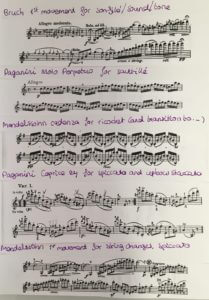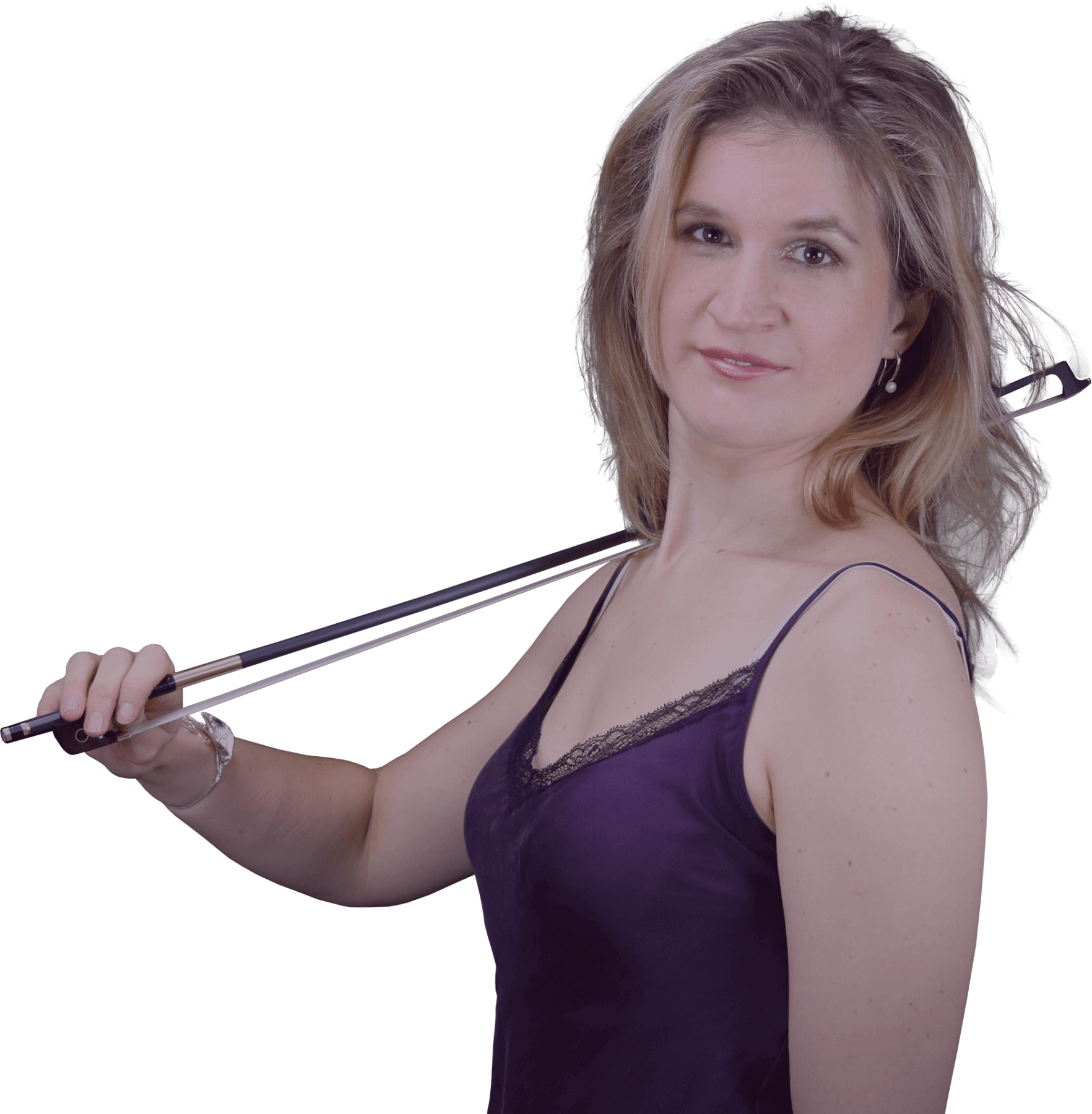What to Play When Buying a Violin Bow?
How to try out violin bows and find your ideal bow?
In this article you’ll learn how to discover the differences and the exact phrases I play:
A different violin bow can make a huge different in your sound and bowing technique. It can be the secret to your beautiful sound!
When you buy your first violin, you focus on the sound and quality of the violin. The bow usually comes ‘with it’. A couple of years later, it can be very interesting to search for a bow that matches your playing and your instrument perfectly.
A good bow can make your violin sound better. Also you can develop your bowing technique and tone production further with a bow that helps you. Trying out different bows and discover the possibilities can deepen your violin playing.
Picking a bow is even more personal than picking a violin
 I own a violin shop in Holland for over ten years and when clients buy a violin, I can demonstrate several instruments. Based on the sound, the client can form an opinion. Of course a violin will sound different played by a different player, but in the basis the character of the instrument will be the same.
I own a violin shop in Holland for over ten years and when clients buy a violin, I can demonstrate several instruments. Based on the sound, the client can form an opinion. Of course a violin will sound different played by a different player, but in the basis the character of the instrument will be the same.
When looking for a bow, I always have to think of this Harry Potter scene, where Harry visits Ollivander’s shop to select a wand. ‘The wand chooses the wizzard’.
Of course buying a violin bow isn’t that magical, but it’s extremely personal. One bow isn’t necessarily better or worse than the other, however there are general quality differences, but it needs to ‘fit’ you.
Don’t get overwhelmed
The first time you’re going to try out bows, you’ll be like a kid in the candy store. You want to grab and try every bow. This can be fun for a while, but to make a good decision, you should limit your choices. Start with a selection of three to five bows.
The first selection of bows
When this is your first time trying out different violin bows, you need to build your frame of reference. The first selection can be very diverse, so you can see what’s ‘on the market’.
In case you’ve tried out bows before and you know what you’re looking for, you can narrow down the first selection based on balance, weight or stiffness. Even if you’re experienced, keep all options open. Don’t limit yourself too much to one brand, one maker or one price range.
Keeping track and selecting
When you notice a bow is ‘meh’ or you struggle with it, reject it immediately. The first nudge is the most accurate. Besides that it’s easier to decide what bows you don’t want than to try out fifty bows and pick one.
Reject bow after bow, until one or two favorites remain. Add some new bows to your selection, so you’ll have a second round of five bows. Repeat this process depending on the size of the assortiment of your violin shop.
What to play when looking for a violin bow?
There are two things you want to compare: the sound and the playability. Sometimes it can be difficult to tell what is “play” and what is “sound”, as both overlap when you play properly.
Play very short fragments
First of all play small fragments of music or scales. The short memory of our brain has a huge capacity for complex sounds, but keeps information only for about 18 seconds. So play only 8 to 12 notes on one string in one position.
I understand that you want to get to know each bow fully before switching to the other. However, this is not the best way to notice differences and compare. Play small fragments and switch a lot.
Explore these ‘tricky’ notes and positions for the sound of the violin bow
There are three regions on every bowed instrument that are especially difficult. They help telling a difference. These are the first position on the lowest string (violin G, viola and cello C), the third position of the second highest string (A resp. D) and fifth position and up on the highest string (E, resp. A).
Explore different bowing techniques for the playability of the violin bow
After discovering the differences in sound, play short fragments in different bowing techniques. Remember to try one bowing technique on each bow and not all bowing techniques on one bow before switching to the next. In this way, it’s much easier to find the differences.
Depending on what bowing techniques you know, try the following:
- A very, very slow (put down) spiccato in forte
- Very rapid short notes in detaché
- Very slow bow strokes in pianissimo (whole bow, frog to tip)
- Alternating between a fast spiccato and legato to discover how the bow switches between different bowing techniques and how you can control it
Hi! I'm Zlata
Let me help you find a great bow for your violin, so you can improve your bowing technique and sound quality:

Hi! I'm Zlata
Classical violinist helping you overcome technical struggles and play with feeling by improving your bow technique.
Prepare fragments of music with different bowing techniques
Apart from some technical runs, also try out the bows in ‘real music’. This is what we buy that beautiful violin bow for, don’t we? You’ll notice that your expression flows better with one bow than the other.
Ideally you don’t have to think about WHAT you play, so you can focus fully on noticing the differences between the bows.
In my shop (despite the relaxing atmosphere and charming sales person, haha) clients sometimes get nervous. Mainly amateur players aren’t used to play alone when other people are listening. Of course it’s very valuable to bring a friend, your orchestra buddy or teacher along, but it can make you a little nervous to play. Suddenly you forget all those phrases you think you know by hart.
Download my ‘bow try out phrases schedule’
 Yup, it probably needs a more catchy name, but perhaps my personal sheet of music can help you make your own. Of course the repertoire you use can be totally different, but it gives you an idea. It’s on the right and you can click on it to see the large version.
Yup, it probably needs a more catchy name, but perhaps my personal sheet of music can help you make your own. Of course the repertoire you use can be totally different, but it gives you an idea. It’s on the right and you can click on it to see the large version.
Remember to not give a concert, but limit the fragment you play before switching to the next bow to 18 seconds! Don’t play the entire fragment you see in my schedule.
How was your experience with trying out violin bows?
I’d love to read your comments below this article. Also tell me more about the bow you have now and what you love about it! Read here about my own bow.
Would you like to see the most expensive, cheapest, best and worst violin bows demonstrated and discussed by two professional violinists?
Together with concert violinist Giedre I’ve made an extensive video series where we play with and discuss many types and brands of violin bows to help you make a good choice.


One more article in the long line.
Not sure I will get through them all in one night but I am trying LOL 🙂
Thanks for reading my articles, Sherylin, hope you’re also enjoying all the review and demonstration videos in the bow guide you downloaded :).
Currently building my own cello bow. Having just recently taken up the cello, I’ve found that, due to an accident to my right arm when I was young, a normal cello bow and bow hold are not possible.
So as with my double bass bow I have designed my own bow and frog to overcome my disabilities.
Wow, great that you were able to design your own bow! Can you tell us a little more about it and what makes it work for you?